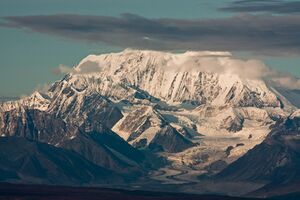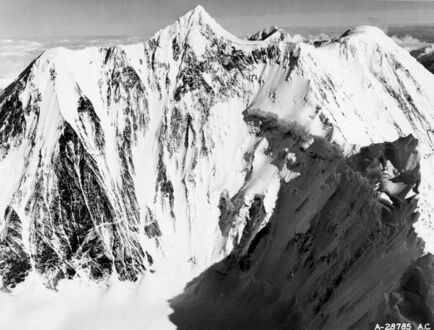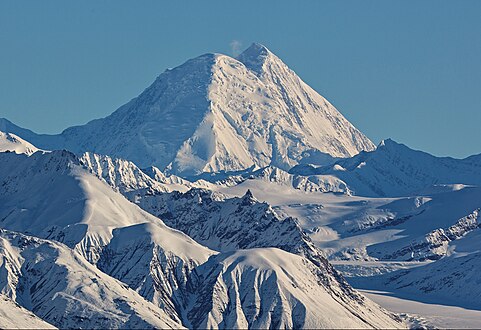Earth:Mount Hayes
| Mount Hayes | |
|---|---|
 | |
| Highest point | |
| Elevation | 13,832 ft (4,216 m) [1] |
| Prominence | 11,487 ft (3,501 m) [1] |
| Listing |
|
| Coordinates | [ ⚑ ] : 63°37′15″N 146°42′55″W / 63.62083°N 146.71528°W |
| Geography | |
| Location | Southeast Fairbanks Census Area, Alaska, United States |
| Parent range | Alaska Range |
| Topo map | USGS Mount Hayes C-6 |
| Climbing | |
| First ascent | 1941 by Bradford Washburn, Barbara Washburn, Benjamin Ferris, Sterling Hendricks, Henry Hall, William Shand |
| Easiest route | snow/ice climb (Alaska grade 2+) |
Mount Hayes is the highest mountain in the eastern Alaska Range, in the U.S. state of Alaska. Despite not being a fourteener, it is one of the largest peaks in the United States in terms of rise above local terrain. For example, the Northeast Face rises 8,000 feet (2,440 m) in approximately 2 miles (3.2 km). This large vertical relief contributes to Mount Hayes being the 51st most topographically prominent peak in the world.[2]
The mountain was named in 1898 by W. J. Peters and A. H. Brooks of the U.S. Geological Survey for Charles Willard Hayes (1858–1916), a geologist with the Survey from 1887 through 1911.[3] Mount Hayes was first climbed on August 1, 1941, by Bradford Washburn, Barbara Washburn,[4] Benjamin Ferris, Sterling Hendricks, Henry Hall, and William Shand.[5]
Today's standard climbing route is the East Ridge (Alaska Grade 2+). Mount Hayes is not frequently climbed due to its remoteness and the resulting access difficulties.[citation needed]
Climate
Based on the Köppen climate classification, Mount Hayes is located in a subarctic climate zone with long, cold, snowy winters, and mild summers.[6] Temperatures can drop below −20 °C with wind chill factors below −30 °C. This climate supports glaciers on its slopes including the Hayes Glacier. Precipitation runoff from the mountain drains into tributaries of the Tanana River drainage basin. The months May through June offer the most favorable weather for climbing or viewing.
See also
- List of mountain peaks of North America
- List of mountain peaks of the United States
- List of Ultras of the United States
References
- ↑ 1.0 1.1 "Alaska & Hawaii P1500s - the Ultras" Peaklist.org. Retrieved 2012-03-03.
- ↑ "World Top 100 by Prominence". http://www.peakbagger.com/list.aspx?lid=403.
- ↑ "Mount Hayes". United States Geological Survey. https://geonames.usgs.gov/apex/f?p=gnispq:3:::NO::P3_FID:1403263.
- ↑ Borneman, Walter R. (2003). Alaska : saga of a bold land (1st ed.). New York, NY: HarperCollins. p. 323. ISBN 0-06-050306-8.
- ↑ "Mount Hayes Alaska". http://bivouac.com/MtnPg.asp?MtnId=7652.
- ↑ Peel, M. C.; Finlayson, B. L.; McMahon, T. A. (2007). "Updated world map of the Köppen−Geiger climate classification". Hydrol. Earth Syst. Sci. 11. ISSN 1027-5606.
Sources
Michael Wood and Colby Coombs, Alaska: A Climbing Guide, The Mountaineers, 2001.
Gallery
Mt. Hayes and the eastern Alaska Range mountains, as seen from the Denali Highway,
L→R: Mt. Balchen, Mt. Hayes, Moby Dick, Mt. Shand
External links
Template:NA highestTemplate:NA prominentTemplate:NA isolated
 |






